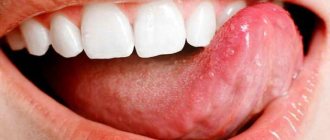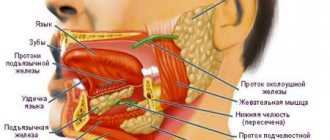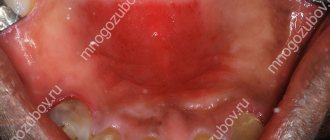Many people ask a completely logical question when they find blue veins under the tongue: what can this mean and does it indicate the development of any disease? We hasten to reassure you that in most cases this phenomenon is considered absolutely normal, due to the peculiarities of blood circulation, vessels located close to the surface and a number of other factors caused by physiological processes.
However, some diseases and borderline conditions can provoke the appearance of blue veins under the tongue, so it is important to learn to distinguish normality from pathology.
We will tell you how to do this further.
Anatomical structure of the tongue
To better understand the reasons for the appearance of blue veins, one should turn to the anatomical features of the structure and functioning of the human tongue.
It is a muscular organ covered with a mucous membrane. The tongue has many nerve endings, thanks to which the necessary signals are sent to the central nervous system.
The tongue consists of two main parts - the body, which can be easily seen with the help of a mirror, and the root, located near the pharynx. They are separated from each other by a V-shaped terminal groove. The surface of the body is rough due to the presence of multiple papillae on it, which are responsible for taste, temperature and pain perception.
In the middle of the lower part of the organ, the mucous membrane forms a frenulum , which connects it to the mucous membrane of the oral cavity. On the sides there are fringed folds, converging to the tip. It is between them and the frenulum that the elements of the circulatory system are visible.
The lingual artery is responsible for the blood supply to the lingual tissues; with its help, oxygen-enriched blood is supplied to the organ. This is how the tongue is nourished. Venous outflow is provided by a complex of lingual vessels connecting to the internal jugular vein. It is the change in their color that most often causes concern among people.
Why do blue veins appear under the tongue?
Since ancient times, changes in structure, color, and the formation of plaque on the surface of the tongue have been considered evidence of disturbances in the functioning of internal organs . That is, it acted as a kind of identifier of a person’s health status.
Bluish vessels, as already noted, are not always a pathological sign, but in some cases they, like a litmus test, make it possible to promptly suspect any disorders in individual organs and systems.
If the appearance of the sublingual vascular pattern changes, you should consult a doctor who will give an expert assessment of what is happening.
It’s worth noting right away that the presence of any disease is not limited to just increased coloration of the tongue; it should be considered, rather, as an additional sign. Let's consider a number of reasons that provoke such a clinical manifestation.
Nutrient deficiency
A lack of B vitamins can affect the appearance of not only blood vessels, but the entire oral cavity. In particular, when there is insufficient intake of vitamin B2, known as riboflavin, similar symptoms appear in the body.
In addition, a person becomes susceptible to a number of diseases of the oral cavity and throat, such as stomatitis, pharyngitis, tonsillitis , he regularly develops cracks on his lips that do not heal for a long time, the color of the tongue surface also changes, darkens and acquires a purple tint.
This condition is corrected by additional intake of vitamins in tablet form and selection of an appropriate diet.
Respiratory diseases
Insufficient saturation of the circulatory system with oxygen due to various pathologies of the respiratory system leads to increased coloration of the lingual vessels , even black. For any of the diseases of the lungs and bronchi, the main symptoms are characterized by lack of air, coughing with or without sputum, and the presence of wheezing, which can be heard when listening to the chest with a phonendoscope.
High cholesterol
Disturbed lipid metabolism and the appearance of fatty plaques significantly disrupt the natural blood flow and nutrition of organs. For this reason, the sublingual space may have an excessively dark color.
Circulatory disorders
In most cases, it is problems with the circulatory system that provoke visual darkening of the vascular pattern. In particular, varicose veins in the sublingual area can appear as a result of:
- increased intravascular pressure as a result of heart failure due to atrial fibrillation and flutter and valve defects;
- hereditary predisposition, characterized by some thinning of individual walls, as a result of which nodes and bloating appear;
- hemorrhoids - a pathological condition accompanied by a violation of the outflow of blood with the formation of nodes localized in the rectal area. You can learn more about varicose veins of the rectum from our article;
- decrease in the elasticity of vascular walls due to age-related changes.
Possible reasons
Blue veins under the tongue can be a consequence or manifestation of various diseases. Most often this is associated with diseases of the cardiovascular system, but there are diseases of fungal and viral origin in which such a manifestation is possible.
Glossalgia
Glossalgia is a disease that manifests itself through blue veins under the tongue, burning, and pain. Symptoms can spread not only to the sublingual area, but also to the lips, palate, and mucous membranes. At the same time, there are no more obvious and pronounced signs of the disease.
The causes of glossalgia are:
- strokes and heart attacks;
- glossalgia often occurs against the background of syphilitic lesions;
- diseases of viral origin.
A complicating factor may be the presence of endocrine diseases, pathologies of the immune system, or problems with the circulatory system.
Phlebeurysm
The most relevant and popular cause is varicose veins of the sublingual veins.
Among the causes of inflammation and blueness of the veins under the tongue are:
- high blood pressure associated with insufficient or abnormal heart function. In this case, damage to the valves is noted;
- viral diseases affecting the brain;
- haemorrhoids. When hemorrhoidal veins become inflamed, the walls expand and become more tortuous. This leads to blockage of the veins with blood clots;
- a genetic mutation in which the walls of blood vessels or some parts of them become thinner. This causes such veins to protrude on various parts of the body;
- reduced elasticity of the walls. This change in the body occurs with age. You may also notice disturbances in blood flow.
Most often, the disease manifests itself in older people. Middle-aged women are also at risk. In men, glossalgia is less common.
Dehydration and overheating
Blue veins under the tongue can be the body's reaction to temperature changes.
Dehydration and overheating of the body lead to loss of body fluids, which causes the following reactions:
- change in tongue color;
- thickening of the blood due to loss of fluid, which leads to blue veins;
- formation of microcracks on the lips, in the mouth;
- dry tongue, yellow coating.
You can fix the problem yourself - you need to drink the optimal amount of liquid, taking into account the temperature, and also avoid direct sunlight.
Burns or injuries
A common cause of blue veins in the sublingual area is mechanical or chemical effects on the tongue.
Mechanical damage may include:
- eating solid foods;
- exposure to cutlery due to careless use;
- bitten tongue;
- incorrectly performed dental procedures. This can include not only damage caused by brushing your teeth, but also a visit to an unqualified dentist.
Mechanical damage leads only to a temporary change in the tongue. Longer-term ones are caused by chemical damage - the ingestion of potent or toxic substances that cause a burn to the oral cavity.
Hematomas
Hematomas in the oral cavity are a relatively common manifestation of various diseases. The mechanism of hematoma formation includes rupture of the vessel and compaction of the leaked blood. The resulting bubble covers the mucous membrane, which leads to darkening of the integument.
The causes of hematomas in the oral cavity are:
- manifestation of an allergic reaction;
- mechanical or chemical effects on the mucous membrane;
- stress;
- manifestation of chronic injury.
Also, one should not exclude the possibility of multiple hematomas.
Blue veins under the tongue
In some cases, blue veins due to the formation of a hematoma can cause:
- hypertension;
- diabetes;
- diseases of the circulatory system;
- avitaminosis;
- kidney diseases;
- stomatitis.
In this case, a specialist can determine the specific disease.
Avitaminosis
Vitamin deficiency, which causes fragility of blood vessels, can also cause blueness of the veins of the sublingual area. Iron deficiency anemia is a fairly common disease characterized by low levels of hemoglobin and red blood cells.
Symptoms of the disease depend on the course and type of anemia.
Most often distinguished:
- increased sensitivity to cold;
- noise in ears;
- lack of air;
- paleness of the mucous membranes and lips;
- dry skin;
- cracks on the lips.
You can also note the desire to eat earth or chalk. People with anemia often like the smells of gasoline, acetone, or paint.
Painful sensations
Swollen blue veins that appear under the tongue indicate the development of varicose veins. Due to anatomical features, the vessels themselves cannot hurt due to the absence of nerves in them.
Due to the course of varicose veins , they expand and put pressure on the nerve endings located in the immediate vicinity, causing pain in the sublingual area. It is these sensations that non-medically savvy people confuse with pain in the vessel.
In addition, late stages of the development of the disease provoke violations of the integrity of the integument due to the formation of ulcers, which will definitely cause discomfort.
promptly seeking qualified help , you can get complications from varicose veins in the form of thrombophlebitis. Blockage of the lumen of the sublingual vessel by a thrombus will inevitably make itself felt not only by visual changes, but also by physical pain.
If, during dental surgery, when a tooth was pulled out, blue veins with characteristic swelling were noticed under the tongue, you should consult the doctor who performed the extraction. He will be able to examine the picture in detail, draw appropriate conclusions and, if necessary, refer you to a specialized specialist.
Read more about massage for varicose veins in our material.
Sublingual veins hurt
Often, when visiting a doctor, a person complains that the veins under the tongue hurt. But there are no nerve endings in the vessels and therefore they cannot physically hurt, so such complaints are fundamentally wrong.
Painful sensations can come from nerves located in close proximity to the veins due to their pinching.
Pain can also occur in the skin covering the vessels, which may be swollen, have minor injuries or ulcers. With varicose veins of the sublingual veins, pain occurs due to pressure on the nerve endings from the walls of swollen vessels or the development of varicose ulcers. The cause of pain can be thrombophlebitis - an inflammatory process in the walls of the veins themselves and its partial blockage with a blood clot.
Thrombophlebitis on the tongue is a dangerous condition
How to diagnose
If you suspect the development of varicose veins, the only correct decision would be to consult a specialized doctor - a phlebologist. He will conduct a visual examination and collect anamnesis, after which he will prescribe additional studies to obtain comprehensive information on a particular case.
Ultrasound examination of the affected areas is an accessible and informative method of diagnosis for varicose veins. With its help, qualitative indicators of blood outflow are checked , allowing one to determine the presence or absence of blood clots that pose a real threat to health. Sometimes radiography is prescribed using a special contrast agent.
Despite the fact that women are more susceptible to developing varicose veins, its manifestations in the sublingual area occur equally often in both sexes.
We wrote in detail about the methods of diagnosis and treatment of varicocele on the left testicle in our article.
Possible consequences and complications
Blue veins located under the tongue are manifestations of diseases.
If left untreated, the following consequences are possible:
- glossalgia does not threaten human health, but reduces the quality of life. You can often notice a coating on the tongue or swelling, which leads to a change in the perception of taste;
- hematomas and mechanical damage to the tongue also reduces the quality of life. There is pain when eating and talking. Chemical burns are dangerous due to bacterial contamination with subsequent spread of infection;
- If iron deficiency anemia is left untreated, the disease can progress to more advanced stages. A reduced hemoglobin content in the blood leads to hypotension, dizziness and a deterioration in quality of life.
Despite the fact that iron deficiency anemia is a fairly common disease (about 30% of people), only in some representatives it is manifested by blue discoloration of the mucous membranes.
Blue veins of the sublingual region are a kind of identifier of pathologies of internal organs. The manifestation itself is not dangerous, since in some cases they are the norm for a certain category of people. If this symptom appears in combination with other manifestations, it is necessary to consult a specialist to determine the cause.
How to treat
Modern methods of treating varicose veins can be divided into medicinal and surgical. The former are used to slow down and stop the course of the disease in the initial stages, from initial manifestations to stage 2 disease.
Surgery is a panacea for advanced disease. However, it is the latter that has the most pronounced result and allows you to get rid of not only the cosmetic problem, but also the possible development of complications caused by this pathology.
The choice of the necessary treatment method is the prerogative of the attending physician alone, who can correctly assess the patient’s condition.
Conservative therapy involves taking medications with various pharmacological effects, namely venotonics, anticoagulants, antiplatelet drugs . Some of them come in various forms and are used both internally and topically.
Blue swollen veins that appear under the tongue, photos of which can often be seen on the Internet, can be treated surgically or by injecting a sclerosing substance into the venous cavity, causing it to stick together.
Veins are removed by microphlebectomy or laser coagulation. Any of these techniques is aimed at restoring proper blood circulation. We described in our material how varicocele manifests itself and is treated in adolescents.
Treatment
If the disease is associated with weakness of the walls of blood vessels and occurs during pregnancy, overweight, in old age and does not cause inconvenience, then no special treatment is required. Pregnant women need to visit a specialist - a phlebologist, who will give the necessary recommendations for prevention and select compression garments. It is important to lead a healthy lifestyle, monitor your weight, and carry out general strengthening activities. Locally, for skin manifestations of the disease, ointments are recommended, which can be purchased freely in pharmacies or with a doctor’s prescription. There are now a wide variety of them. The phlebologist will also prescribe a drug depending on the stage of the disease that is right for you.
If the disease is caused by more serious problems and dilated vessels appear in other parts of the body, then complex treatment is necessary. It includes treatment of the underlying pathology by a specialized specialist and local treatment, including surgery, for the manifestation of varicose veins of the lower extremities, hemorrhoidal, inguinal veins, and scrotal veins.
A phlebologist treats the affected vessels. Today there are modern and very effective techniques. The most popular of them are sclerotherapy (injection of a special drug into a vessel that causes sclerosis), laser treatment of varicose veins, and phlebectomy surgery (removal of the damaged part of the vessel through incisions in the skin).
How dangerous?
It is impossible to give a definite answer to this question due to various reasons for the manifestation of such symptoms.
If the structure of the vessel is not disturbed, but it is blue or black in color, this may be a normal variant. Venous blood is darker in color than arterial blood due to its saturation with carbon dioxide. Additional blueness is given by the vascular wall, mucous membrane and other tissues that can distort the real shade of blood.
Another situation that also does not require treatment and is considered completely natural is the aging of the body. , a natural thinning of the vascular walls occurs , resulting in dark blue veins appearing under the tongue.
A change in not only the color, but also the structure of the sublingual venous lines, the formation of nodules, multiple or single, the appearance of painful sensations - all this is a reason to contact a specialist to carry out a differential diagnosis and establish the root cause of the manifestation of such symptoms. Read more about varicocele in a 14-year-old teenager in our material.
Do I need to follow a diet?
If any of the reasons listed above have been medically established as causing the appearance of a cosmetic defect, it would not be a bad idea to reconsider your own gastronomic preferences.
Each of these conditions requires at least a slight adjustment of the diet , especially if a person prefers to eat “junk” food. The adjustment is as follows:
- in increasing the volume of consumption of products of plant origin - vegetables, fruits, herbs in fresh, baked form, as well as in salads;
- excluding excessively fatty meat, spicy, salty and fried foods from the menu. When cooking food, you should choose baking, boiling or steaming;
- in regular consumption of sea fish and seafood, as the main source of saturated acids;
- in choosing pasta made from durum wheat or vegetables as a side dish for meat or fish dishes, depending on individual preferences;
- You can’t give up cereals; they are a source of vitamins and microelements. The most useful are buckwheat, oatmeal, and pearl barley;
- You should use olive or any other vegetable oil as a salad dressing. As an exception, it is allowed to consume homemade mayonnaise once a week for this purpose in limited quantities - no more than 30 ml.
Types of stains
Spots on a child’s tongue can be different, both in shape and color. Depending on this, all the spots on the mucous membrane of the uvula can be divided into several groups.
Geographic language
In this case, the mucous membrane is very reminiscent of a map of countries and continents. This change can occur in children of all ages, including newborns. The tongue looks patchy and has areas of small bald patches that connect to each other. A similar type of mucous membrane is observed in the following pathologies:
- For diseases of a hormonal nature;
- With helminthic infestation;
- For diseases of the digestive system.
Geographic tongue spots can be of different shapes and sizes. In many cases, they are not a sign of a disease at all, and do not pose a danger to the child.
White spots
White spots on the mucous membrane are in most cases caused by fungi. Popularly, this pathology is called thrush. Candidiasis develops against the background of weakened immunity in children of different ages. Such spots have a cheesy appearance; they can cover not only the surface of the tongue, but also the cheeks and palate. When a fungal infection of the oral cavity occurs, the child cannot eat normally, he becomes moody and restless.
As first aid, the child’s oral cavity is treated with a soda solution. Prepare such a solution at the rate of 1 teaspoon of soda per glass of boiled water.
Red spots
Such spots almost always indicate an inflammatory or infectious disease of the oral cavity. The cause of red spots can be glossitis, stomatitis, herpes and bacterial dermatosis. The cause of this phenomenon may be an allergic reaction and consumption of red foods.
Quite often, the appearance of such spots is accompanied by pain and a burning sensation in the tongue. Due to pain, the child may refuse to eat and be capricious. Sometimes body temperature rises.
Depending on the cause, antifungal agents, antibiotics and antiviral drugs may be prescribed. It is recommended to treat areas of inflammation with antiseptic solutions such as Miramistin or Furacilin.
Dark spots
Often appear on the tongue after consuming certain foods. They are not dangerous and disappear after rinsing the mouth or brushing the tongue.
Black spots may appear as a result of prolonged treatment with antibacterial drugs. In this case, treatment comes down to normalizing the microflora of the digestive organs.
A very rare cause of dark spots are deep degenerative processes when areas of the mucous membrane die off. This condition requires urgent medical attention.
Yellow spots
Occurs when a child has problems with the digestive tract. Such spots densely cover the base of the tongue and the rest of its surface. Plaque consists of dead epithelium and is difficult to remove. This phenomenon is almost always accompanied by bad breath.
To eliminate the problem, you should undergo examination and treat diseases of the digestive tract. After treatment, the yellow plaque quickly disappears.
Blue spots
Blue spots on the tongue of children are extremely rare. They talk about problems with the cardiovascular system. To eliminate this phenomenon, sometimes it is simply necessary to normalize blood circulation in the vessels.
The cause of blue spots can be a hemangioma. In this case, there is most often one spot. Treatment in this case is always surgical.
Other spots
Normally, the tongue is covered with many taste buds, which give the mucous membrane a velvety appearance. With tongue injuries, burns and some inflammatory diseases, the taste buds die, forming smooth pink areas.
Such spots do not cause discomfort to the baby; his taste may only change slightly. This condition cannot be treated, since the taste buds are not restored.
When you see different spots on a child’s tongue, you should not panic, but you cannot ignore this phenomenon.
The baby should be shown to a doctor who will correctly diagnose and, if necessary, prescribe treatment. This article is for informational purposes only, please consult your doctor for details! Ask your doctor about contraindications and side effects.
Treatment methods at home
The basis of home therapy is following the doctor’s recommendations and maintaining a healthy lifestyle. Quitting smoking, drinking alcoholic beverages, and observing basic dietary restrictions are the main requirements in the therapy process.
If varicose veins are diagnosed in the sublingual area in the initial stages, it is advisable to use various decoctions and infusions of herbal components that have anti-inflammatory and restorative effects as additional measures. Let's look at the best recipes:
- Mix a glass of water at room temperature with a tablespoon of natural apple cider vinegar. Divide the contents into 2 doses and consume immediately after meals;
- Divide the sour apple into 6 slices, fill them with 500 ml of boiling water, leave for 4 hours. Then mash the fruits, add 3 teaspoons of honey and take the resulting liquid three times a day, 150 ml before meals;
- nutmeg-alcohol tincture has also proven itself as an effective remedy in the fight against diseases of the circulatory system. Mix 250 grams of crushed nuts with a bottle of vodka and leave for 20 days in a cool place, protected from direct sunlight. Take 20 drops half an hour before meals.
Under no circumstances should you rely on traditional medicine alone and refuse drug therapy prescribed by your doctor. This can aggravate the course of the disease and provoke complications.
Preventive actions
The following tips will help reduce the chances of pathological changes in the sublingual area:
- nutrition should be regular and balanced;
- oral hygiene measures should be carried out 2 times a day, morning and evening;
- Regular medical examinations by highly specialized doctors will allow you to identify the slightest changes at the initial stages, when they are still being successfully treated. Such events should be held at least once a year;
- if there is a hereditary predisposition to varicose veins, constant moderate physical activity should be maintained;
- Sanitation of the oral cavity at the dentist will avoid the proliferation of pathogenic microflora in it, which becomes the impetus for the formation of pathology.
As you know, it is much easier to prevent the development of a disease than to cure it later, so you should not neglect these simple rules.










